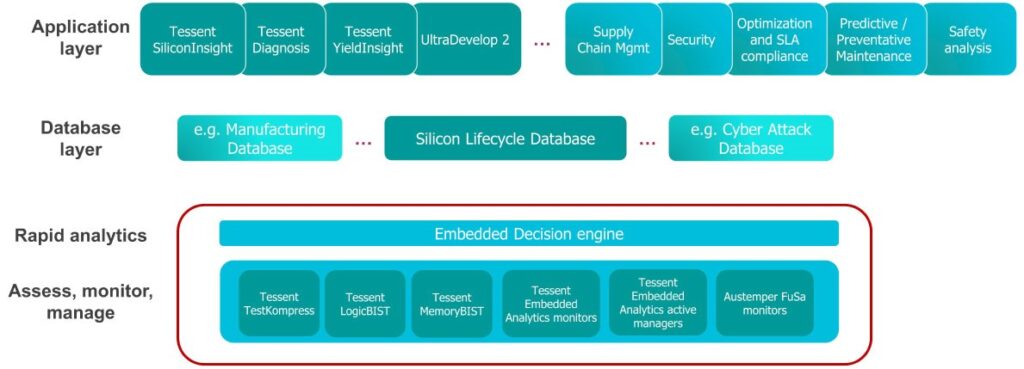What is silicon lifecycle management?
The next step in IC test and monitoring
by Aileen Ryan – Senior Director of Portfolio Strategy, Siemens Digital Industries Software
Silicon lifecycle management is an emerging paradigm in the semiconductor industry that is based on the well-established practice of product lifecycle management (PLM). Silicon lifecycle solutions (SLS) brings to IC designer capabilities to better plan and optimize ICs, comply with industry standards and meet legal liability requirements. SLS addresses the recent compelling needs to monitor and analyze data regarding the design, realization, deployment, and field service of the silicon device.
The impetus for SLS is seen in the fact that electronics are permeating deeper into our lives, and the technology itself continues to scale in complexity, and devices and data are increasingly interconnected. This interconnectedness is a major source of threat in terms of cybersecurity breaches. But new business models in the automotive industry – like mobility as a service – rely inherently on connectedness. Keeping devices up to date and safe requires regular over-the-air software updates, and providers want performance and usage monitoring deployed devices. All this requires the use of some form of lifecycle solution.
SLS will be required in the next generation of safety-critical devices deployed in cars, where chip makers must ensure the reliability, safety, and security of SoCs in mission-critical systems, which requires visibility into the SoCs so you can monitor and assess the performance, functional safety and cybersecurity of the device throughout its entire service life. SLS is also useful for the datacenter sector, where greater product reliability, safety, and security have direct bottom-line consequences.
So that’s the general overview of why we need SLS now. But what about the practical features of a silicon lifecycle solution? First, it establishes a holistic approach to improve existing semiconductor design, manufacture, and deployment processes. For this, the Tessent Silicon Lifecycle Solution includes advanced design-for-test (DFT) techniques that enhance IC quality, increase test efficiency, and enable diagnosis-driven yield analysis (DDYA).
SLS also includes functional monitoring augmentations to the silicon, or embedded analytics. Embedded analytics gather data about the chip’s real-world functional behavior which is valuable as a manufacturer goes through the process of systems integration and bring-up for an end product. The same types of data can be used for continuous optimization of systems after deployment – for instance ensuring load balancing between many CPUs in high-performance computing (HPC) operations.
Elements of silicon lifecycle solutions include:
- On-chip hardware and design for test (DFT) logic to monitor and assess circuit behavior
- Embedded analytics to acquire relevant data in a manageable form and to formulate and implement a local response where necessary
- Open interfaces to allow data sharing, data processing, and response definition in the cloud
- Collaborative business models that allow a holistic approach to the value chain
SLS is the framework through which we can collect data from the chip and from the processes involved in its production, process potentially huge volumes of data, and deliver actionable information. The information will be available when and where it is needed. SLS, then, becomes a holistic, data-driven process that enhances semiconductor design, realization, and utilization. It might sound difficult to establish SLS in place of the ad hoc and fragmented processes in place in many semiconductor companies now, but the bottom-line benefits are substantial.
The first step in creating an SLS is for the semiconductor architect to include design augmentations that gather data from the chip and facilitate the rest of the process. Then, the semiconductor company needs to work with players across the ecosystem, including semiconductor IP providers, fabrication facilities, OEMs, service companies, and database and analytics providers.
Siemens Digital Industries Software (Siemens EDA) offers a Silicon Lifecycle Solutions portfolio within the Tessent product family. Broadly, we consider 4 distinct layers:
- Assess, monitor, and manage
The foundation of the Tessent Silicon Lifecycle Solutions platform, sensors and monitors gather data about the system for use at various stages of the IC lifecycle. Structural monitors are the traditional DFT logic and functional monitors are Tessent Embedded Analytics IP that observe the interactions between silicon subsystems and between the silicon and the embedded software. - Rapid analytics
The embedded decision engine detects, understands, and responds to threats. In end-use applications where fast reaction time is critical for security, safety, and privacy concerns such as in transportation or data centers, rapid analytics offers a compelling competitive advantage. - Database layer
Applications that gather and store the large amount of data generated by the on-chip monitoring IP. This involves data from multiple vendors and sources, which means that open APIs, partnerships, federation capabilities, and participation in relevant standards organizations are critical factors for success. - Application layer
Applications that can be enabled or enhanced by the use of data from silicon systems, some of which are provided by Siemens, and some of which are created and owned by our customers and partners.

To learn more about the Tessent Silicon Lifecycle Solutions from Siemens, read the whitepaper here: https://resources.sw.siemens.com/en-US/white-paper-tessent-silicon-lifecycle-solutions
Figure 1: Silicon lifecycle solutions cover the design, realization, and utilization of complex SoCs to address debug, test, yield management, safety and security, and in-field optimization.
Figure 2: The Tessent Silicon Lifecycle Solutions platform.


